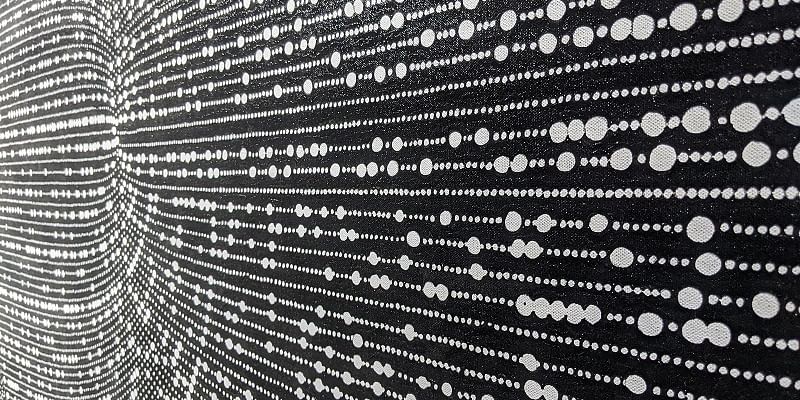Launched in 2014, PhotoSparks is a weekly feature from YourStory, with photographs that celebrate the spirit of creativity and innovation. In the earlier 620 posts, we featured an art festival, cartoon gallery. world music festival, telecom expo, millets fair, climate change expo, wildlife conference, startup festival, Diwali rangoli, and jazz festival.
Treasure Art Gallery in New Delhi is host the month to the unique exhibition, Codes of a future, Traces of the ancient by contemporary artist Anni Kumari.
Curated by Sanjana Shah, the solo show combines themes from mathematics and cosmology. The 10 large distinct works fill the carefully designed and lit space, with the black-and-white images profiled in stark contrast.
Conveyed with a compelling experience for the audience, the artist connects past and future, material and spiritual. The grids exhibit geometrical precision, capturing intriguing patterns, ratios, and duality.
Anni’s previous works included Algorithms and Blurring Boundaries. She has won a range of awards and grants from India and the US. Originally from Jamshedpur, she is a visiting professor at the Department of Visual Arts, Ashoka University.
The two-floor gallery was founded by Tina Chandroji, a graduate of the J.J. School of Applied Art. It also hosts seminars, workshops, lectures, discussions, and talk sessions to build communities and conversations around art.
The painting series is titled Intersections, Echo, Bluff Point, and Some Equations Have Multiple Identities. The acrylic and oil works on canvas were completed in the period 2018-2022. They are priced from Rs 3.75 lakh to Rs 9 lakh.
In this extended interview, Anni shares her artistic journey, creative process, and tips for audiences and artists.
Edited excerpts below:
YourStory [YS]: What does art mean to you?
Anni Kumari [AK]: For me, art is a constant search to know and experience how we are connected to the cosmos.
[YS]: How would you describe your own unique style? How did you develop it in terms of technique, form, theme, and message?
[AK]: I think my style is a combination of two aspects—functional logic and aesthetics. So if I were to describe it in a (hyphenated) word, I would say “functional aesthetics”.
My style developed very gradually after I graduated from art school when I began thinking about my interest in mathematics as a universal language and exploring ritualistic traditions and folk art that have a strong basis in geometry and mathematical logic.
Then I did several experiments to devise a methodology that allowed me to work with only one pigment (black) and achieve a form that was dense and nebulous, and had both centripetal and centrifugal properties.
What I intend to convey to the audience is the experience of looking at a form that has spatial/cosmic relevance and to allow them to think of the labour and the time involved in the process of creation.
[YS]: What is your creative process. How do you go about getting an idea for an artwork, and then developing it?
[AK]: I usually take different approaches for different works, but mostly it all begins with an observation that I then develop by researching and reading about it.
Then follows a series of small-scale drawings, mostly based on memory and intuition. I then look through several visual references in an attempt to decide how I would go about creating large-size drawings involving precise geometrical forms with lots of minute details.
Once the structural aspect of my drawing is clear to me, then begins the laborious process of precise brushwork that continues for several weeks and months before the work is ready.
[YS]: How does an artist learn from mistakes and failures? What are ways to learn and move ahead?
[AK]: I think the best way to learn, grow and to move ahead is to keep making and displaying works. Because that is the only way we can understand how scale, materials, space, and light play a very important role in the way the work is viewed and experienced.
[YS]: What has been your journey so far?
[AK]: My journey has been slow but consistent. I have had two solo shows and three curated group shows in India in the past one year. I have created about 20 large-scale works in the past two and half years.
[YS]: Do you also teach and conduct workshops?
[AK]: I have taught both theory and practice courses at various institutions in India and currently I am a visiting faculty in the Department of Visual Arts at Ashoka University, Sonipat.
I have also conducted several workshops, especially for children as part of two fellowship programmes by ArtReach India.
[YS]: How would you define success for yourself as an artist, architect?
[AK]: For me success means sustenance. As long as I can sustain my practice and can touch the life of another person in some way through art-making or teaching, I feel successful.
[YS]: How can art appreciation be improved in India?
[AK]: By bringing in structural and policy change in art education with more grants, scholarships and fellowships for art projects, exhibition-making, research, writing and dissemination of knowledge on art practices through collaborations between institutions, organisations, and individuals.
[YS]: What works did you specially prepare for this exhibition? Can you say a few words about how you created them?
[AK]: I created a series of three works, each 7X5 feet, with acrylic and oil on canvas, called Intersections. These works were created through a laborious process involving a precise construction of vertical, horizontal and spiral grids using beam compass, protractors and scales of different kinds.
Natural numbers between 1 and 1,00,000 were plotted onto the spiral grids. I then selected prime numbers and a combination of prime and composite numbers from the rest of the numbers.
This led to the creation of unique mathematical patterns that have a close connection with the calculation of days, months and the occurrence of cosmic phenomena such as the eclipses followed in the ancient Luni-solar calendars called Panchang.
[YS]: What other projects are you working on now?
[AK]: I am working on a series of large-scale collages and a set of multiple drawings based on ancient astronomical instruments, known as yantras.
[YS]: What was your experience at the exhibition in terms of feedback and new ideas?
[AK]: There is a renewed interest in my works post the opening of the show. Most people have appreciated the way the works have been displayed. I have got critical responses in terms of what other materials I could use for my works and the way I could divide my works into parts.
For me, this was an opportunity to see how a body of my works came together and also to be able to view past and more recent works simultaneously. This has given me new ideas about revisiting some of the projects that I had initiated earlier but have not taken them ahead.
I also realised the importance of documenting the different stages of my process. Hopefully, I plan to display fragments of the making of the works for my forthcoming shows.
[YS]: How are you keeping yourself engaged during these times of coronavirus? How has it affected your work?
[AK]: I think it has allowed me to slow down and to devote myself more fully to art-making and gardening. The focus of my practice remains unchanged but there is an element of mortality that is gradually entering my works.
[YS]: What are your recommendations to the audience on how to approach and interpret art?
[AK]: I would say that the audience needs to encounter the works with fresh eyes, without thinking too much about the message or the meaning behind the works.
We have a real need to be surrounded by beauty and this joy of seeing something beautiful is in itself the message.
[YS]: What are your words of advice for aspiring artists?
[AK]: Work hard, be patient and trust your intuition!
Now, what have you done today to pause in your busy schedule and find new avenues to apply your creativity?
Tina Chandroji
Anni Kumari
(All exhibition photographs were taken by Madanmohan Rao on location at Treasure Art Gallery.)
See also the YourStory pocketbook ‘Proverbs and Quotes for Entrepreneurs: A World of Inspiration for Startups,’ accessible as apps for Apple and Android devices.







![Read more about the article [Funding alert] Biocraft Innovation Technology raises undisclosed pre-seed round from JITO Angel Network](https://blog.digitalsevaa.com/wp-content/uploads/2021/07/Untitled-11561552442504-300x150.png)
![Read more about the article [Funding alert] Darwinbox turns unicorn; raises $72M in Series D round led by Technology Crossover Ventures](https://blog.digitalsevaa.com/wp-content/uploads/2022/01/Image42iw-1643037235793-300x150.jpg)

